As you can see this is my planning of what is going to happen in the window and what it's going to look like and also what artist that I'm responding to.
As you can see this I started with the drawing of my brother in which this photo was taken on my holiday to Italy. In this photo I drew the estimate size I wanted to draw and so after when I finished doing that I very neatly followed the lines that I needed to cut out and it worked when I finished it.
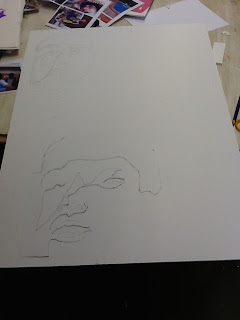
In this photo you can see what I was working with which was the polyboard and in my head I drew it out perfectly and so I continued...
This is a drawing of me that I took from the holiday photos and as you can see I turned it into a stencil as I did for every drawing that I did for the project and so I did the following of drawing and cutting the lines.
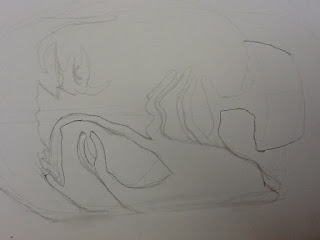
This is a close up from the completed view of the cut out shape
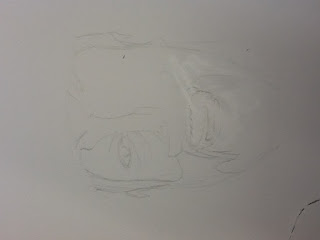
This is a drawing of my brother which it was hard to do because there were so many lines and in this photo you can see my rubbing out in which I corrected afterwards
When I finished all of the cutting from the drawings, I started to paint the polyboard with the experimental mark making techniques that I learnt and as you can see I used a PVA glue brush which I found it hard to use because it's so flat meaning that the paint dries out with one swipe
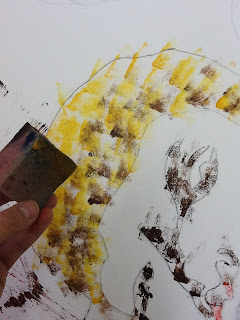
In this photo as you can see I used a sponge to make a patten-like feature towards the mark making technique and just like child's play it was easy to use because all I had to do was dip it in the paint and dip it as much as I can on the Polyboard
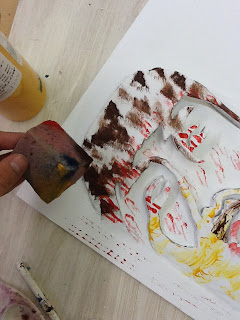
Yet again I used the sponge because it was an object that can be used multiple times meaning putting different colours on each corner and in this photo you can see that I used it on my cut out drawing. In the photo below you can see the completed version

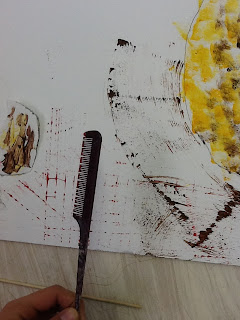
In this photo it shows another object that we use in our every day lives to prevent this feature of a comb being used in a swift motion which you can see from the paint. I painted with the comb for the background which became handy because instead of doing a swift motion I did a pattern motion which you can see from the photo having red little boxes. in the photo below you can see the red pattern even more
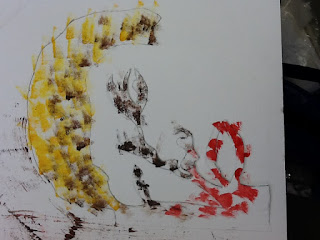
This photo shows the completed version of my little brother that I drew and cut out.
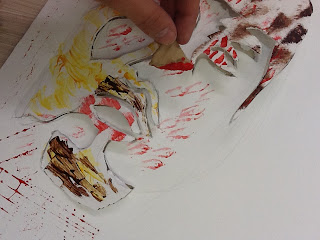
in this photo it shows that I used a piece of cardboard to create the shape that is on the polyboard which I was meant to do it for the lips then i got carried away ...
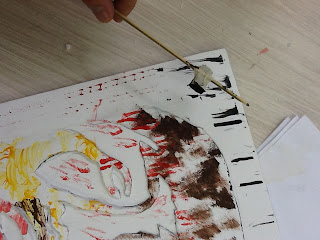
As again I mix things up to create different patterns for example in this photo as you can see I used a stick
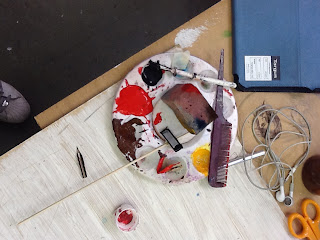
In this photo I took a picture of the objects that I used to paint my drawings
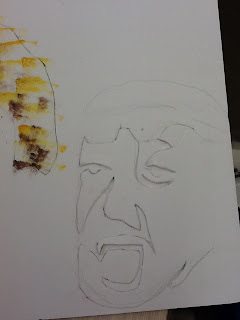
This is a drawing of my dad in a stencil because then it allows me to cut it out easy and it worked
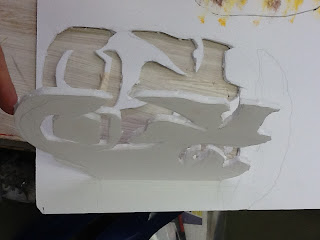
This is a photo of proof that it works from the drawing of my dad
As you can see I used the end of the scissors to paint with and as you can see what I done was that I used two different colours such as red and blue, I found this technique hard to do because the pain will build up as i swipe giving that fating look.
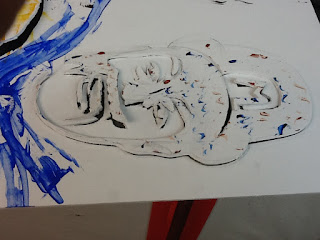
In this photo you can see that I completed the painting part of Marco's cut out
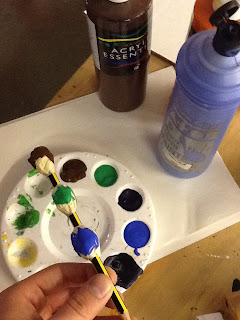
As you can see I made something up again and as you can see it's a pencil with three ball like masking tape around it, which was handy because it allowed me to create a nice pattern with three different colours.
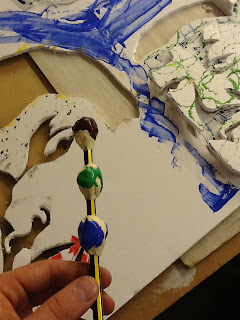
This is a photo of before my project wasn't painted with this object
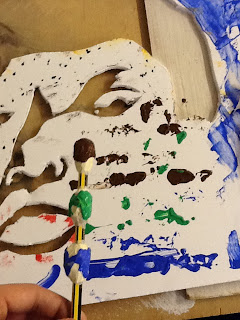
This is what it looked like after because I did an over layered method which as you can see I started at the bottom then moved up and as you know it will catch the other paint that was layered before, which as you can see on the work it starts to mix
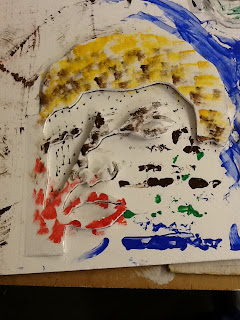
this photo is the finished version of the painting of the object that I made with a pencil and some masking tape. In this photo the paint makes the actual cut out drawing look more difficult to figure out what it is
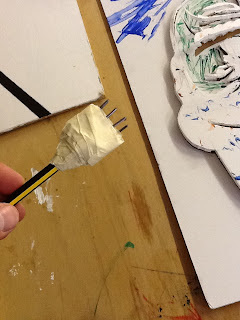
this is another thing that I made, with some masking tape and nails and a pencil, it does look scary but it's completely harmless because in the process of painting with this it was actually hard because I didn't tape it well, which means that every time I dipped it into paint the nails would move in meaning it'll give me a different stroke to what I wanted in the first place and also when I pressed down to make those patterns ( in the photo below) it'll sink in the masking tape.
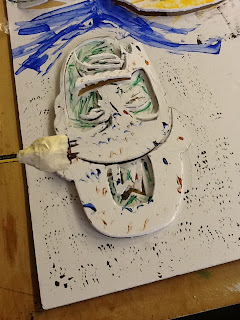
Even though its upside down you can still see what the finial painting with that object actually turned out and I must say it turned out good because its just a nice repeated pattern around the cut out piece.
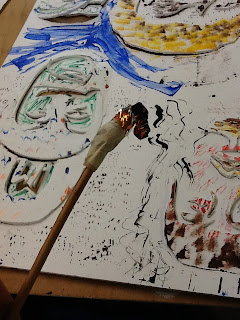
This is another object that I made up, it's a stick with a chocolate wrapper on it. The process of using this was really easy because it was so loose and the paint would go everywhere as I stroked it on the paper, as you can see that the outcome of this object turned out to be a random affect because you can see that at the top there's a thick yet bold paint then it starts to fade and become thin and as I turned the stick each time I dipped it into the paint it gave me another affect on the stroke.
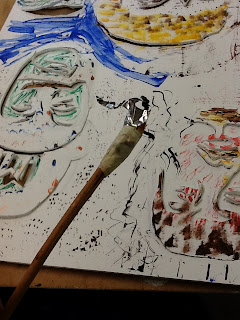
This is what I was on about when I was talking about it would give me a different affect on each time I turned the stick when I dipped it into the paint, this was the other side of the wrapper and that side gave me the thin and faded affect on the stroke
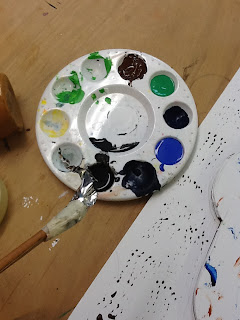
This is just a photo of me using the object in the process painting
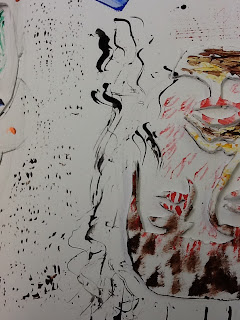
As you can see this is a photo of the stick wrapper brush I made and this is the final painting up close
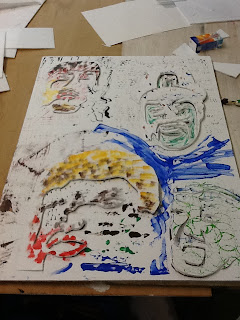
I couldn't get a good photo of the final piece, but yes as you can see I used the artist of Peter Callesen due to the inspiration of making the heads of my brothers and dad into an art form of what Peter Callesen does and also the Experimental Mark Making which I learn from the workshop and as you can see I found it fun and exciting.
 This is piece is by Gary Hutchins, this piece is called six-necked guitar. When I saw this piece I thought it was amazing because I've seen a Three-necked guitar but never in my life seen this. I think it's creative because you can't physically hold it but to just show it can be made is a mysterally feeling to actually play it.
This is piece is by Gary Hutchins, this piece is called six-necked guitar. When I saw this piece I thought it was amazing because I've seen a Three-necked guitar but never in my life seen this. I think it's creative because you can't physically hold it but to just show it can be made is a mysterally feeling to actually play it. This work is called Crochetdermy bear it was made by Shauna Richardson. when I first saw this I thought it was different because most things in the V&A Power of Making area were mostly about human things and yet this work stood out from the rest because it was something different within the theme
This work is called Crochetdermy bear it was made by Shauna Richardson. when I first saw this I thought it was different because most things in the V&A Power of Making area were mostly about human things and yet this work stood out from the rest because it was something different within the theme 















































